Report: Occupational Health Management Program in Mining Quarry
VerifiedAdded on 2021/06/15
|30
|6433
|246
Report
AI Summary
This report details an occupational health management program developed for a mining quarry with 20 employees. It addresses the risks associated with Respirable Crystalline Silica (RCS), particularly the threat of silicosis and other health issues. The program emphasizes health surveillance through air monitoring and medical check-ups, including respiratory function tests and chest X-rays. It also highlights the importance of behavioral attitude changes, employee involvement, and training to promote a safe work environment. The report outlines ethical considerations and performance indicators to measure the program's success. An action plan spanning three years aims to minimize RCS exposure to 0.1 mg/m3 through engineering controls and respirators. The recommendations include protecting employees from exceeding the OSHA limit of 50µg/m3. The program also includes pre and post-employment medical examinations, regular monitoring, and data confidentiality to ensure effective surveillance and worker well-being. The program aims to change attitudes, behaviors, and promote health practices at the workplace.

Occupation Health Management 17
Occupation Health Management Program
(Author’s name)
(Institutional Affiliation)
Occupation Health Management Program
(Author’s name)
(Institutional Affiliation)
Paraphrase This Document
Need a fresh take? Get an instant paraphrase of this document with our AI Paraphraser
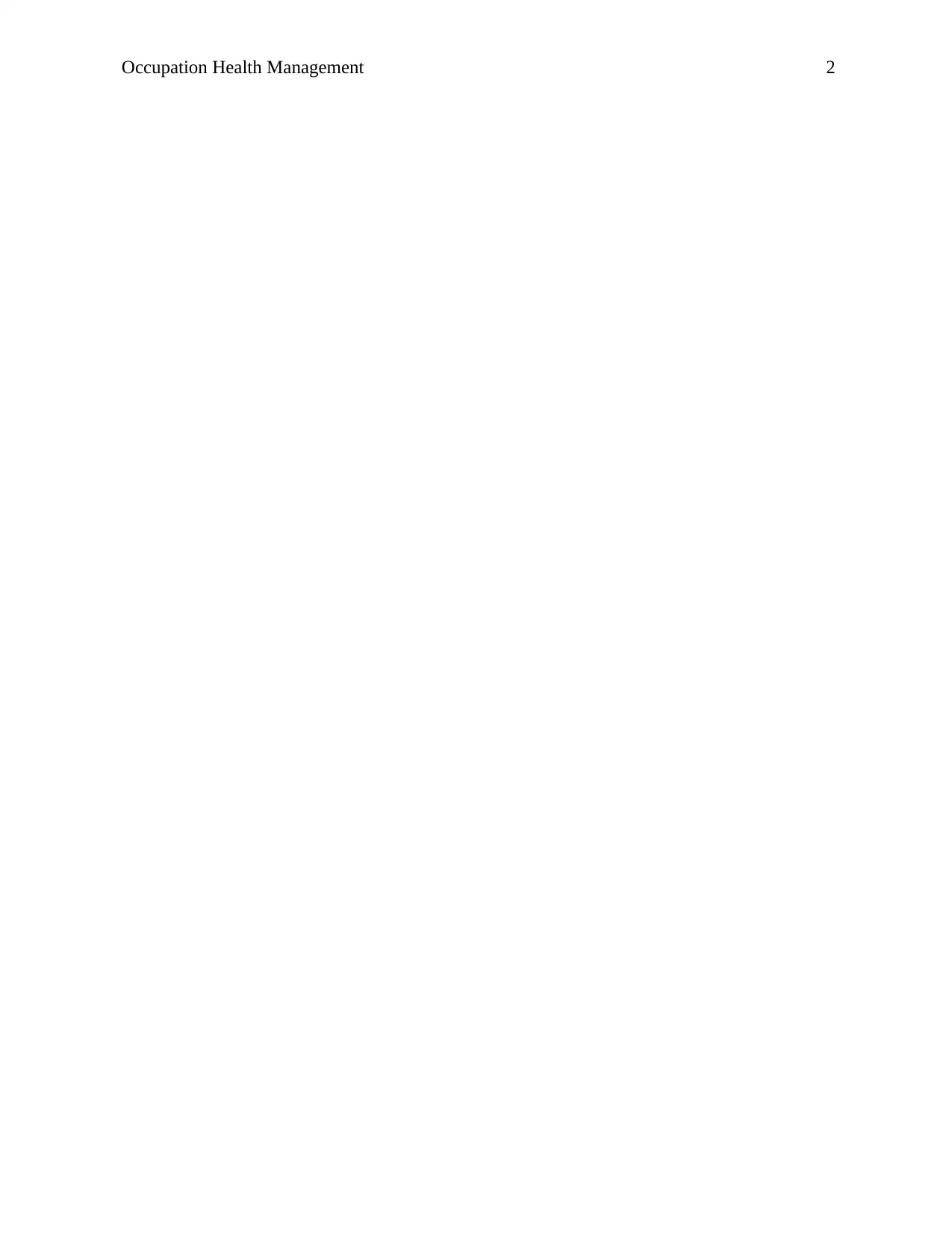
Occupation Health Management 2
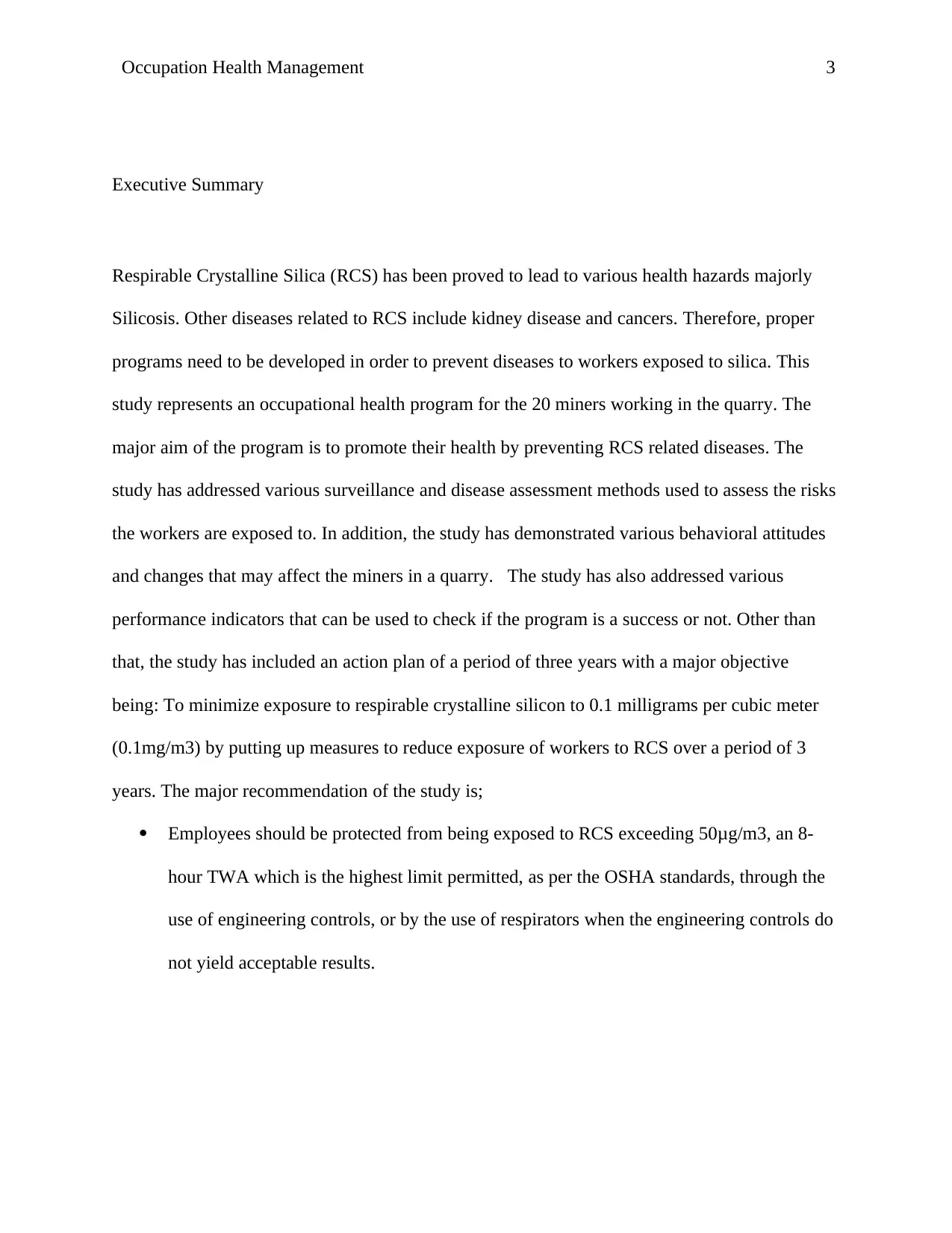
Occupation Health Management 3
Executive Summary
Respirable Crystalline Silica (RCS) has been proved to lead to various health hazards majorly
Silicosis. Other diseases related to RCS include kidney disease and cancers. Therefore, proper
programs need to be developed in order to prevent diseases to workers exposed to silica. This
study represents an occupational health program for the 20 miners working in the quarry. The
major aim of the program is to promote their health by preventing RCS related diseases. The
study has addressed various surveillance and disease assessment methods used to assess the risks
the workers are exposed to. In addition, the study has demonstrated various behavioral attitudes
and changes that may affect the miners in a quarry. The study has also addressed various
performance indicators that can be used to check if the program is a success or not. Other than
that, the study has included an action plan of a period of three years with a major objective
being: To minimize exposure to respirable crystalline silicon to 0.1 milligrams per cubic meter
(0.1mg/m3) by putting up measures to reduce exposure of workers to RCS over a period of 3
years. The major recommendation of the study is;
Employees should be protected from being exposed to RCS exceeding 50μg/m3, an 8-
hour TWA which is the highest limit permitted, as per the OSHA standards, through the
use of engineering controls, or by the use of respirators when the engineering controls do
not yield acceptable results.
Executive Summary
Respirable Crystalline Silica (RCS) has been proved to lead to various health hazards majorly
Silicosis. Other diseases related to RCS include kidney disease and cancers. Therefore, proper
programs need to be developed in order to prevent diseases to workers exposed to silica. This
study represents an occupational health program for the 20 miners working in the quarry. The
major aim of the program is to promote their health by preventing RCS related diseases. The
study has addressed various surveillance and disease assessment methods used to assess the risks
the workers are exposed to. In addition, the study has demonstrated various behavioral attitudes
and changes that may affect the miners in a quarry. The study has also addressed various
performance indicators that can be used to check if the program is a success or not. Other than
that, the study has included an action plan of a period of three years with a major objective
being: To minimize exposure to respirable crystalline silicon to 0.1 milligrams per cubic meter
(0.1mg/m3) by putting up measures to reduce exposure of workers to RCS over a period of 3
years. The major recommendation of the study is;
Employees should be protected from being exposed to RCS exceeding 50μg/m3, an 8-
hour TWA which is the highest limit permitted, as per the OSHA standards, through the
use of engineering controls, or by the use of respirators when the engineering controls do
not yield acceptable results.
⊘ This is a preview!⊘
Do you want full access?
Subscribe today to unlock all pages.

Trusted by 1+ million students worldwide
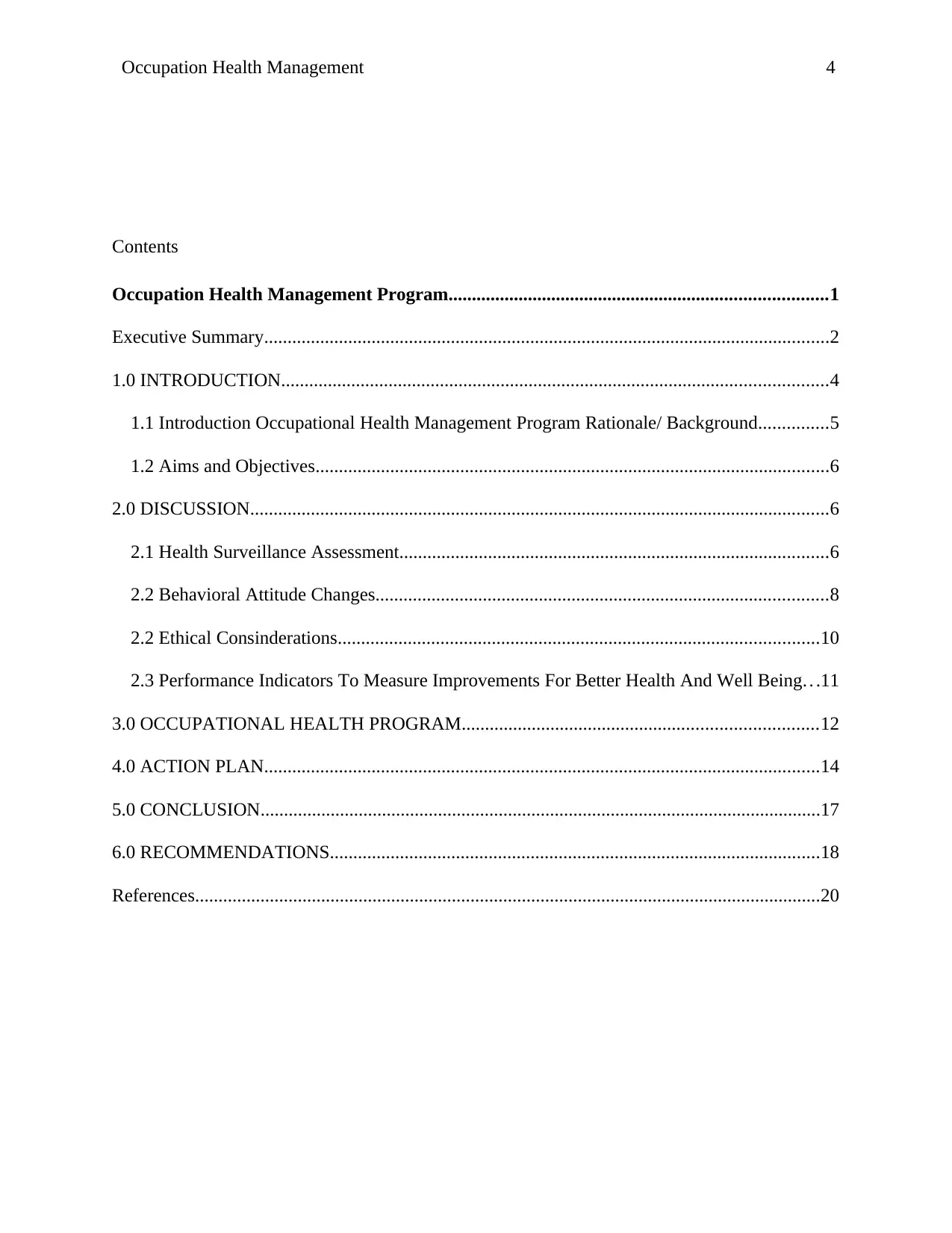
Occupation Health Management 4
Contents
Occupation Health Management Program.................................................................................1
Executive Summary.........................................................................................................................2
1.0 INTRODUCTION.....................................................................................................................4
1.1 Introduction Occupational Health Management Program Rationale/ Background...............5
1.2 Aims and Objectives..............................................................................................................6
2.0 DISCUSSION............................................................................................................................6
2.1 Health Surveillance Assessment............................................................................................6
2.2 Behavioral Attitude Changes.................................................................................................8
2.2 Ethical Consinderations.......................................................................................................10
2.3 Performance Indicators To Measure Improvements For Better Health And Well Being. . .11
3.0 OCCUPATIONAL HEALTH PROGRAM............................................................................12
4.0 ACTION PLAN.......................................................................................................................14
5.0 CONCLUSION........................................................................................................................17
6.0 RECOMMENDATIONS.........................................................................................................18
References......................................................................................................................................20
Contents
Occupation Health Management Program.................................................................................1
Executive Summary.........................................................................................................................2
1.0 INTRODUCTION.....................................................................................................................4
1.1 Introduction Occupational Health Management Program Rationale/ Background...............5
1.2 Aims and Objectives..............................................................................................................6
2.0 DISCUSSION............................................................................................................................6
2.1 Health Surveillance Assessment............................................................................................6
2.2 Behavioral Attitude Changes.................................................................................................8
2.2 Ethical Consinderations.......................................................................................................10
2.3 Performance Indicators To Measure Improvements For Better Health And Well Being. . .11
3.0 OCCUPATIONAL HEALTH PROGRAM............................................................................12
4.0 ACTION PLAN.......................................................................................................................14
5.0 CONCLUSION........................................................................................................................17
6.0 RECOMMENDATIONS.........................................................................................................18
References......................................................................................................................................20
Paraphrase This Document
Need a fresh take? Get an instant paraphrase of this document with our AI Paraphraser
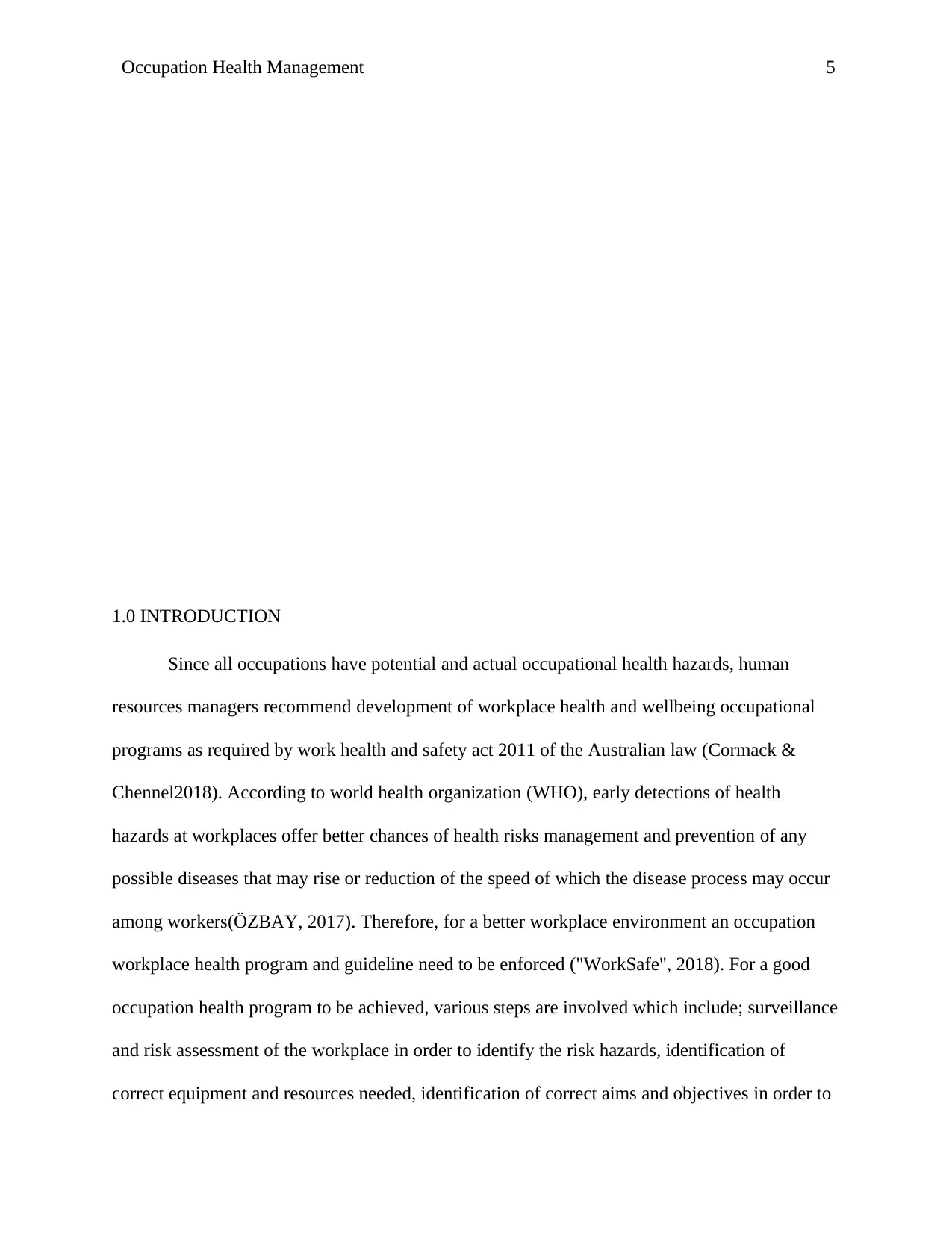
Occupation Health Management 5
1.0 INTRODUCTION
Since all occupations have potential and actual occupational health hazards, human
resources managers recommend development of workplace health and wellbeing occupational
programs as required by work health and safety act 2011 of the Australian law (Cormack &
Chennel2018). According to world health organization (WHO), early detections of health
hazards at workplaces offer better chances of health risks management and prevention of any
possible diseases that may rise or reduction of the speed of which the disease process may occur
among workers(ÖZBAY, 2017). Therefore, for a better workplace environment an occupation
workplace health program and guideline need to be enforced ("WorkSafe", 2018). For a good
occupation health program to be achieved, various steps are involved which include; surveillance
and risk assessment of the workplace in order to identify the risk hazards, identification of
correct equipment and resources needed, identification of correct aims and objectives in order to
1.0 INTRODUCTION
Since all occupations have potential and actual occupational health hazards, human
resources managers recommend development of workplace health and wellbeing occupational
programs as required by work health and safety act 2011 of the Australian law (Cormack &
Chennel2018). According to world health organization (WHO), early detections of health
hazards at workplaces offer better chances of health risks management and prevention of any
possible diseases that may rise or reduction of the speed of which the disease process may occur
among workers(ÖZBAY, 2017). Therefore, for a better workplace environment an occupation
workplace health program and guideline need to be enforced ("WorkSafe", 2018). For a good
occupation health program to be achieved, various steps are involved which include; surveillance
and risk assessment of the workplace in order to identify the risk hazards, identification of
correct equipment and resources needed, identification of correct aims and objectives in order to
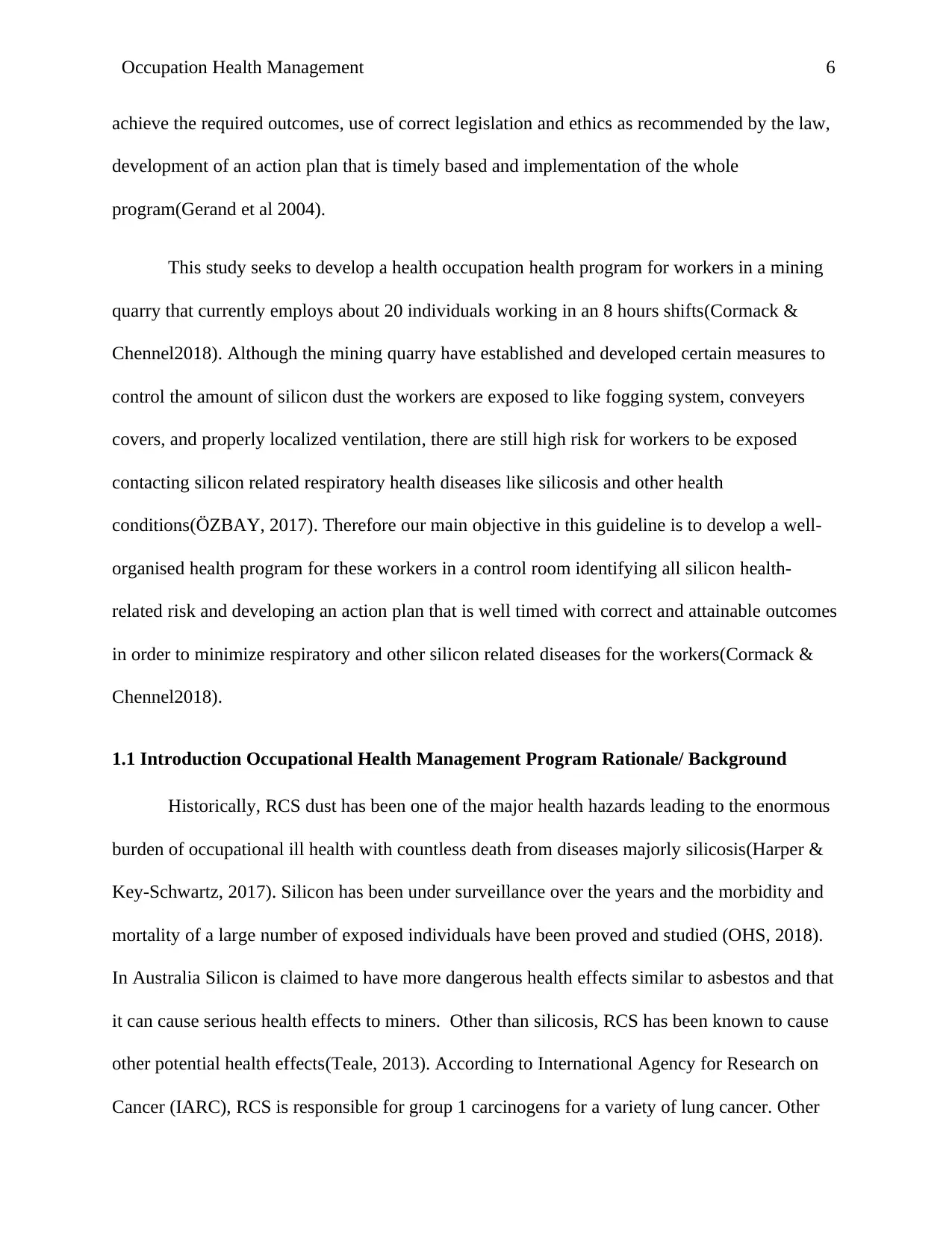
Occupation Health Management 6
achieve the required outcomes, use of correct legislation and ethics as recommended by the law,
development of an action plan that is timely based and implementation of the whole
program(Gerand et al 2004).
This study seeks to develop a health occupation health program for workers in a mining
quarry that currently employs about 20 individuals working in an 8 hours shifts(Cormack &
Chennel2018). Although the mining quarry have established and developed certain measures to
control the amount of silicon dust the workers are exposed to like fogging system, conveyers
covers, and properly localized ventilation, there are still high risk for workers to be exposed
contacting silicon related respiratory health diseases like silicosis and other health
conditions(ÖZBAY, 2017). Therefore our main objective in this guideline is to develop a well-
organised health program for these workers in a control room identifying all silicon health-
related risk and developing an action plan that is well timed with correct and attainable outcomes
in order to minimize respiratory and other silicon related diseases for the workers(Cormack &
Chennel2018).
1.1 Introduction Occupational Health Management Program Rationale/ Background
Historically, RCS dust has been one of the major health hazards leading to the enormous
burden of occupational ill health with countless death from diseases majorly silicosis(Harper &
Key-Schwartz, 2017). Silicon has been under surveillance over the years and the morbidity and
mortality of a large number of exposed individuals have been proved and studied (OHS, 2018).
In Australia Silicon is claimed to have more dangerous health effects similar to asbestos and that
it can cause serious health effects to miners. Other than silicosis, RCS has been known to cause
other potential health effects(Teale, 2013). According to International Agency for Research on
Cancer (IARC), RCS is responsible for group 1 carcinogens for a variety of lung cancer. Other
achieve the required outcomes, use of correct legislation and ethics as recommended by the law,
development of an action plan that is timely based and implementation of the whole
program(Gerand et al 2004).
This study seeks to develop a health occupation health program for workers in a mining
quarry that currently employs about 20 individuals working in an 8 hours shifts(Cormack &
Chennel2018). Although the mining quarry have established and developed certain measures to
control the amount of silicon dust the workers are exposed to like fogging system, conveyers
covers, and properly localized ventilation, there are still high risk for workers to be exposed
contacting silicon related respiratory health diseases like silicosis and other health
conditions(ÖZBAY, 2017). Therefore our main objective in this guideline is to develop a well-
organised health program for these workers in a control room identifying all silicon health-
related risk and developing an action plan that is well timed with correct and attainable outcomes
in order to minimize respiratory and other silicon related diseases for the workers(Cormack &
Chennel2018).
1.1 Introduction Occupational Health Management Program Rationale/ Background
Historically, RCS dust has been one of the major health hazards leading to the enormous
burden of occupational ill health with countless death from diseases majorly silicosis(Harper &
Key-Schwartz, 2017). Silicon has been under surveillance over the years and the morbidity and
mortality of a large number of exposed individuals have been proved and studied (OHS, 2018).
In Australia Silicon is claimed to have more dangerous health effects similar to asbestos and that
it can cause serious health effects to miners. Other than silicosis, RCS has been known to cause
other potential health effects(Teale, 2013). According to International Agency for Research on
Cancer (IARC), RCS is responsible for group 1 carcinogens for a variety of lung cancer. Other
⊘ This is a preview!⊘
Do you want full access?
Subscribe today to unlock all pages.

Trusted by 1+ million students worldwide
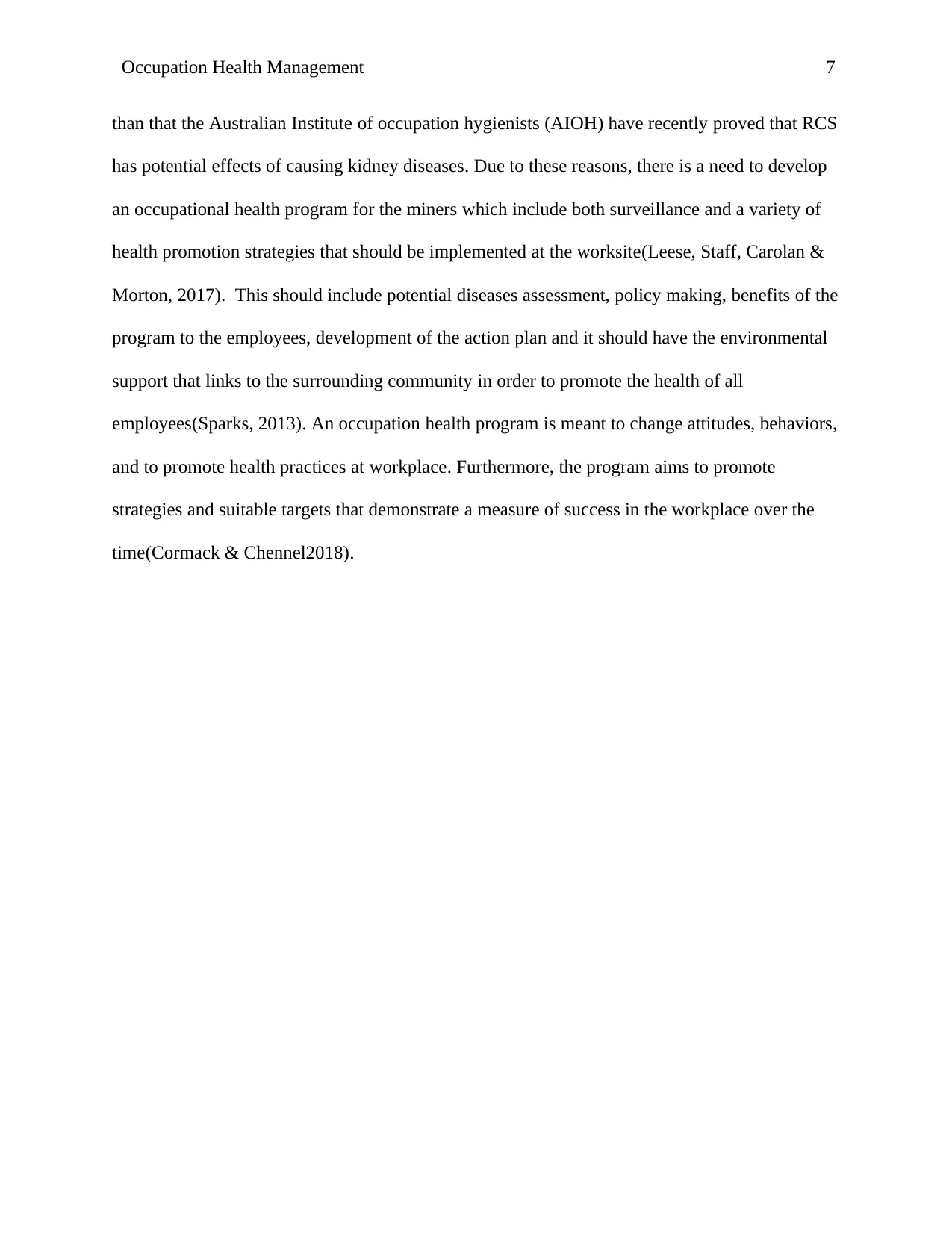
Occupation Health Management 7
than that the Australian Institute of occupation hygienists (AIOH) have recently proved that RCS
has potential effects of causing kidney diseases. Due to these reasons, there is a need to develop
an occupational health program for the miners which include both surveillance and a variety of
health promotion strategies that should be implemented at the worksite(Leese, Staff, Carolan &
Morton, 2017). This should include potential diseases assessment, policy making, benefits of the
program to the employees, development of the action plan and it should have the environmental
support that links to the surrounding community in order to promote the health of all
employees(Sparks, 2013). An occupation health program is meant to change attitudes, behaviors,
and to promote health practices at workplace. Furthermore, the program aims to promote
strategies and suitable targets that demonstrate a measure of success in the workplace over the
time(Cormack & Chennel2018).
than that the Australian Institute of occupation hygienists (AIOH) have recently proved that RCS
has potential effects of causing kidney diseases. Due to these reasons, there is a need to develop
an occupational health program for the miners which include both surveillance and a variety of
health promotion strategies that should be implemented at the worksite(Leese, Staff, Carolan &
Morton, 2017). This should include potential diseases assessment, policy making, benefits of the
program to the employees, development of the action plan and it should have the environmental
support that links to the surrounding community in order to promote the health of all
employees(Sparks, 2013). An occupation health program is meant to change attitudes, behaviors,
and to promote health practices at workplace. Furthermore, the program aims to promote
strategies and suitable targets that demonstrate a measure of success in the workplace over the
time(Cormack & Chennel2018).
Paraphrase This Document
Need a fresh take? Get an instant paraphrase of this document with our AI Paraphraser

Occupation Health Management 8
1.2 Aims and Objectives
The aim of this occupational health management program is to promote health and safety of
miners mining a quarry that currently has around 20 individuals employed. In order to achieve
this aim the health management project has the following objectives:
Identify and conduct health surveillance assessment.
Assess the need for behavioural attitude changes.
Demonstrate ethical considerations needed to develop a program.
Develop an action plan that should be implemented over the time.
2.0 DISCUSSION
2.1 Health Surveillance Assessment
Due to the fact that, RCS only become a health risk when inhaled, the only appropriate
way for conducting comprehensive health surveillance in Australia is air monitoring(Worksafe
Queensland. 2014). Respiratory dust particles for RCS include all portions of airborne materials
that can be inhaled and penetrate up to inner respiratory organs including un-ciliated air
pathways(Cormack & Chennel 2018). There are various strategies used to carry out air
monitoring and analysis("Silica - OHS Reps", 2018). However, the most significant strategy
used include X-ray diffraction which involves the use of various analytical instruments that
measure and determine the level of acceptable RCs concentration normally in an 8-hour
shift("Regulatory framework for occupational health and safety | ALRC", 2018). Given that the
result should always fall under the acceptable RCS as set by the standard the shift may be shorter
even at 4 hours but with proper monitoring, compliance, and use of accredited testing equipment
it can even reach at 8 hours and 12 hours shifts(ÖZBAY, 2017). Once the level of exposure is
1.2 Aims and Objectives
The aim of this occupational health management program is to promote health and safety of
miners mining a quarry that currently has around 20 individuals employed. In order to achieve
this aim the health management project has the following objectives:
Identify and conduct health surveillance assessment.
Assess the need for behavioural attitude changes.
Demonstrate ethical considerations needed to develop a program.
Develop an action plan that should be implemented over the time.
2.0 DISCUSSION
2.1 Health Surveillance Assessment
Due to the fact that, RCS only become a health risk when inhaled, the only appropriate
way for conducting comprehensive health surveillance in Australia is air monitoring(Worksafe
Queensland. 2014). Respiratory dust particles for RCS include all portions of airborne materials
that can be inhaled and penetrate up to inner respiratory organs including un-ciliated air
pathways(Cormack & Chennel 2018). There are various strategies used to carry out air
monitoring and analysis("Silica - OHS Reps", 2018). However, the most significant strategy
used include X-ray diffraction which involves the use of various analytical instruments that
measure and determine the level of acceptable RCs concentration normally in an 8-hour
shift("Regulatory framework for occupational health and safety | ALRC", 2018). Given that the
result should always fall under the acceptable RCS as set by the standard the shift may be shorter
even at 4 hours but with proper monitoring, compliance, and use of accredited testing equipment
it can even reach at 8 hours and 12 hours shifts(ÖZBAY, 2017). Once the level of exposure is
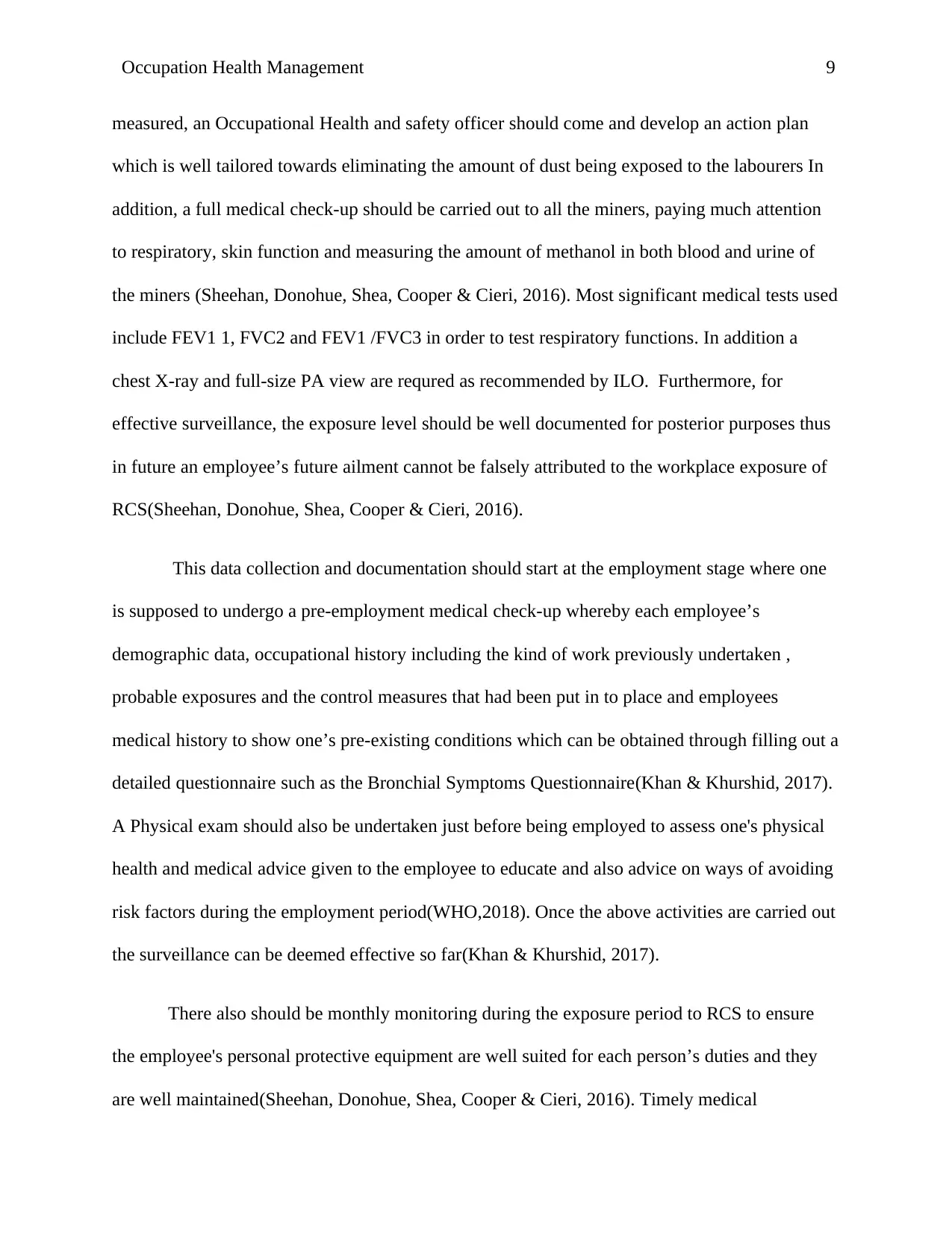
Occupation Health Management 9
measured, an Occupational Health and safety officer should come and develop an action plan
which is well tailored towards eliminating the amount of dust being exposed to the labourers In
addition, a full medical check-up should be carried out to all the miners, paying much attention
to respiratory, skin function and measuring the amount of methanol in both blood and urine of
the miners (Sheehan, Donohue, Shea, Cooper & Cieri, 2016). Most significant medical tests used
include FEV1 1, FVC2 and FEV1 /FVC3 in order to test respiratory functions. In addition a
chest X-ray and full-size PA view are requred as recommended by ILO. Furthermore, for
effective surveillance, the exposure level should be well documented for posterior purposes thus
in future an employee’s future ailment cannot be falsely attributed to the workplace exposure of
RCS(Sheehan, Donohue, Shea, Cooper & Cieri, 2016).
This data collection and documentation should start at the employment stage where one
is supposed to undergo a pre-employment medical check-up whereby each employee’s
demographic data, occupational history including the kind of work previously undertaken ,
probable exposures and the control measures that had been put in to place and employees
medical history to show one’s pre-existing conditions which can be obtained through filling out a
detailed questionnaire such as the Bronchial Symptoms Questionnaire(Khan & Khurshid, 2017).
A Physical exam should also be undertaken just before being employed to assess one's physical
health and medical advice given to the employee to educate and also advice on ways of avoiding
risk factors during the employment period(WHO,2018). Once the above activities are carried out
the surveillance can be deemed effective so far(Khan & Khurshid, 2017).
There also should be monthly monitoring during the exposure period to RCS to ensure
the employee's personal protective equipment are well suited for each person’s duties and they
are well maintained(Sheehan, Donohue, Shea, Cooper & Cieri, 2016). Timely medical
measured, an Occupational Health and safety officer should come and develop an action plan
which is well tailored towards eliminating the amount of dust being exposed to the labourers In
addition, a full medical check-up should be carried out to all the miners, paying much attention
to respiratory, skin function and measuring the amount of methanol in both blood and urine of
the miners (Sheehan, Donohue, Shea, Cooper & Cieri, 2016). Most significant medical tests used
include FEV1 1, FVC2 and FEV1 /FVC3 in order to test respiratory functions. In addition a
chest X-ray and full-size PA view are requred as recommended by ILO. Furthermore, for
effective surveillance, the exposure level should be well documented for posterior purposes thus
in future an employee’s future ailment cannot be falsely attributed to the workplace exposure of
RCS(Sheehan, Donohue, Shea, Cooper & Cieri, 2016).
This data collection and documentation should start at the employment stage where one
is supposed to undergo a pre-employment medical check-up whereby each employee’s
demographic data, occupational history including the kind of work previously undertaken ,
probable exposures and the control measures that had been put in to place and employees
medical history to show one’s pre-existing conditions which can be obtained through filling out a
detailed questionnaire such as the Bronchial Symptoms Questionnaire(Khan & Khurshid, 2017).
A Physical exam should also be undertaken just before being employed to assess one's physical
health and medical advice given to the employee to educate and also advice on ways of avoiding
risk factors during the employment period(WHO,2018). Once the above activities are carried out
the surveillance can be deemed effective so far(Khan & Khurshid, 2017).
There also should be monthly monitoring during the exposure period to RCS to ensure
the employee's personal protective equipment are well suited for each person’s duties and they
are well maintained(Sheehan, Donohue, Shea, Cooper & Cieri, 2016). Timely medical
⊘ This is a preview!⊘
Do you want full access?
Subscribe today to unlock all pages.

Trusted by 1+ million students worldwide
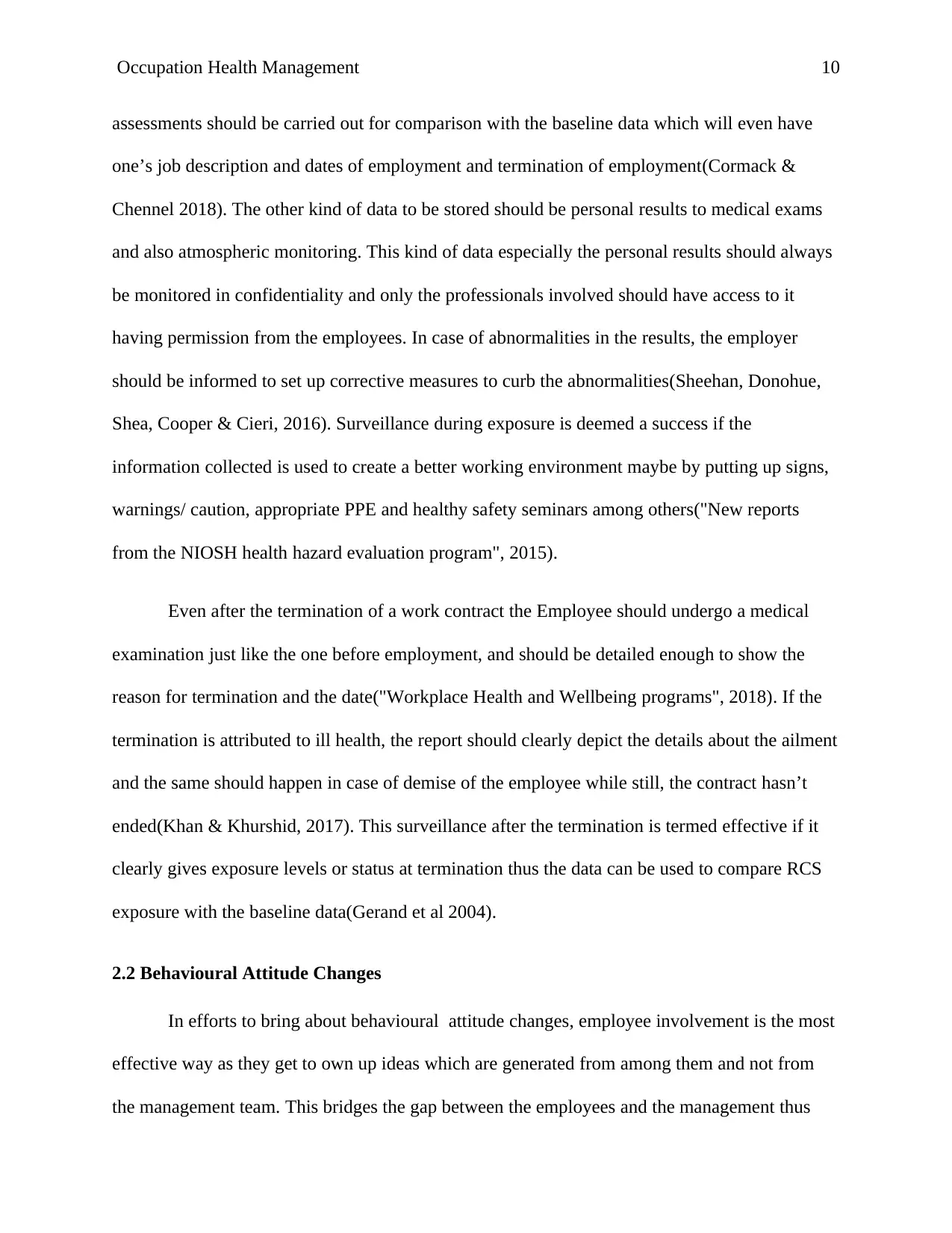
Occupation Health Management 10
assessments should be carried out for comparison with the baseline data which will even have
one’s job description and dates of employment and termination of employment(Cormack &
Chennel 2018). The other kind of data to be stored should be personal results to medical exams
and also atmospheric monitoring. This kind of data especially the personal results should always
be monitored in confidentiality and only the professionals involved should have access to it
having permission from the employees. In case of abnormalities in the results, the employer
should be informed to set up corrective measures to curb the abnormalities(Sheehan, Donohue,
Shea, Cooper & Cieri, 2016). Surveillance during exposure is deemed a success if the
information collected is used to create a better working environment maybe by putting up signs,
warnings/ caution, appropriate PPE and healthy safety seminars among others("New reports
from the NIOSH health hazard evaluation program", 2015).
Even after the termination of a work contract the Employee should undergo a medical
examination just like the one before employment, and should be detailed enough to show the
reason for termination and the date("Workplace Health and Wellbeing programs", 2018). If the
termination is attributed to ill health, the report should clearly depict the details about the ailment
and the same should happen in case of demise of the employee while still, the contract hasn’t
ended(Khan & Khurshid, 2017). This surveillance after the termination is termed effective if it
clearly gives exposure levels or status at termination thus the data can be used to compare RCS
exposure with the baseline data(Gerand et al 2004).
2.2 Behavioural Attitude Changes
In efforts to bring about behavioural attitude changes, employee involvement is the most
effective way as they get to own up ideas which are generated from among them and not from
the management team. This bridges the gap between the employees and the management thus
assessments should be carried out for comparison with the baseline data which will even have
one’s job description and dates of employment and termination of employment(Cormack &
Chennel 2018). The other kind of data to be stored should be personal results to medical exams
and also atmospheric monitoring. This kind of data especially the personal results should always
be monitored in confidentiality and only the professionals involved should have access to it
having permission from the employees. In case of abnormalities in the results, the employer
should be informed to set up corrective measures to curb the abnormalities(Sheehan, Donohue,
Shea, Cooper & Cieri, 2016). Surveillance during exposure is deemed a success if the
information collected is used to create a better working environment maybe by putting up signs,
warnings/ caution, appropriate PPE and healthy safety seminars among others("New reports
from the NIOSH health hazard evaluation program", 2015).
Even after the termination of a work contract the Employee should undergo a medical
examination just like the one before employment, and should be detailed enough to show the
reason for termination and the date("Workplace Health and Wellbeing programs", 2018). If the
termination is attributed to ill health, the report should clearly depict the details about the ailment
and the same should happen in case of demise of the employee while still, the contract hasn’t
ended(Khan & Khurshid, 2017). This surveillance after the termination is termed effective if it
clearly gives exposure levels or status at termination thus the data can be used to compare RCS
exposure with the baseline data(Gerand et al 2004).
2.2 Behavioural Attitude Changes
In efforts to bring about behavioural attitude changes, employee involvement is the most
effective way as they get to own up ideas which are generated from among them and not from
the management team. This bridges the gap between the employees and the management thus
Paraphrase This Document
Need a fresh take? Get an instant paraphrase of this document with our AI Paraphraser
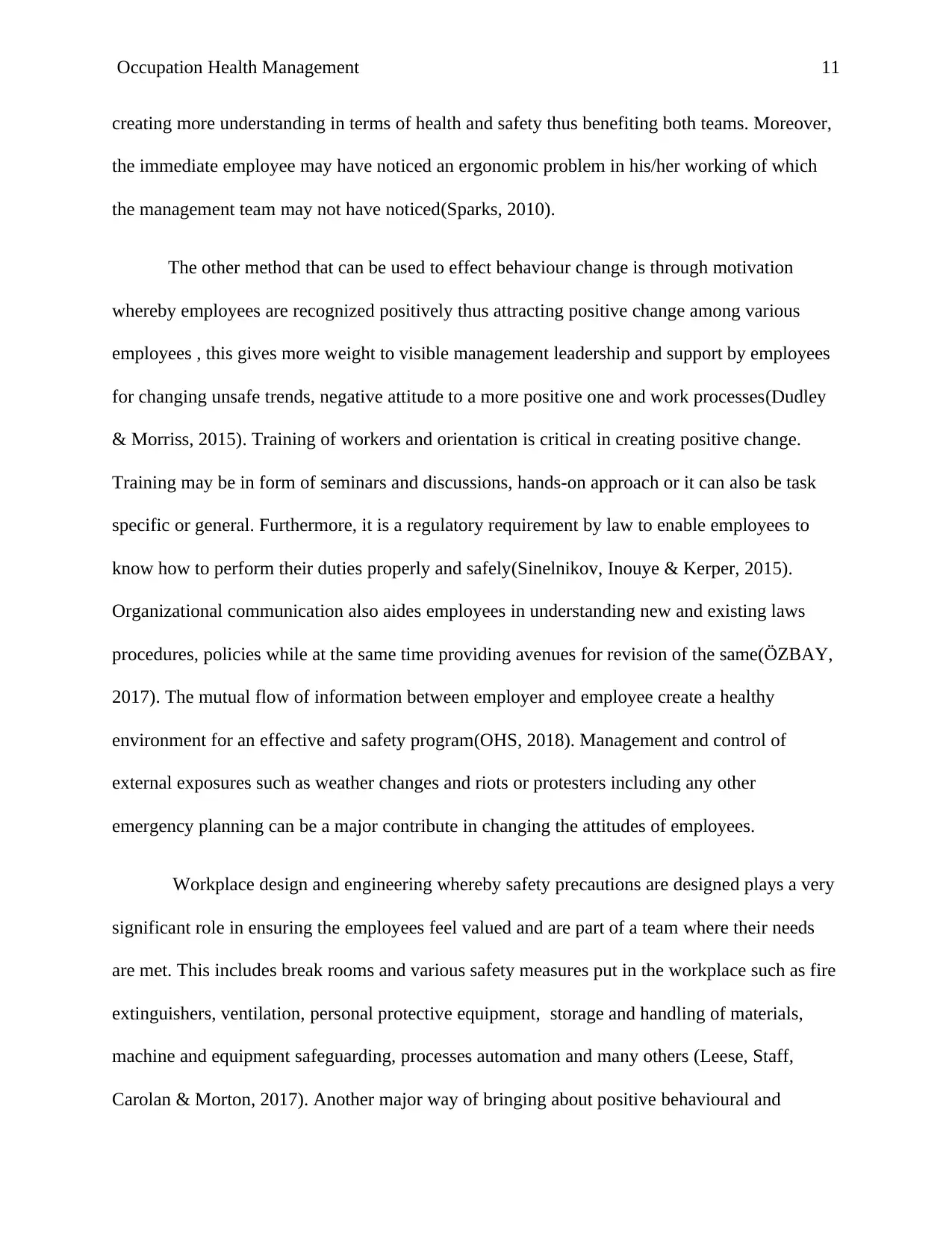
Occupation Health Management 11
creating more understanding in terms of health and safety thus benefiting both teams. Moreover,
the immediate employee may have noticed an ergonomic problem in his/her working of which
the management team may not have noticed(Sparks, 2010).
The other method that can be used to effect behaviour change is through motivation
whereby employees are recognized positively thus attracting positive change among various
employees , this gives more weight to visible management leadership and support by employees
for changing unsafe trends, negative attitude to a more positive one and work processes(Dudley
& Morriss, 2015). Training of workers and orientation is critical in creating positive change.
Training may be in form of seminars and discussions, hands-on approach or it can also be task
specific or general. Furthermore, it is a regulatory requirement by law to enable employees to
know how to perform their duties properly and safely(Sinelnikov, Inouye & Kerper, 2015).
Organizational communication also aides employees in understanding new and existing laws
procedures, policies while at the same time providing avenues for revision of the same(ÖZBAY,
2017). The mutual flow of information between employer and employee create a healthy
environment for an effective and safety program(OHS, 2018). Management and control of
external exposures such as weather changes and riots or protesters including any other
emergency planning can be a major contribute in changing the attitudes of employees.
Workplace design and engineering whereby safety precautions are designed plays a very
significant role in ensuring the employees feel valued and are part of a team where their needs
are met. This includes break rooms and various safety measures put in the workplace such as fire
extinguishers, ventilation, personal protective equipment, storage and handling of materials,
machine and equipment safeguarding, processes automation and many others (Leese, Staff,
Carolan & Morton, 2017). Another major way of bringing about positive behavioural and
creating more understanding in terms of health and safety thus benefiting both teams. Moreover,
the immediate employee may have noticed an ergonomic problem in his/her working of which
the management team may not have noticed(Sparks, 2010).
The other method that can be used to effect behaviour change is through motivation
whereby employees are recognized positively thus attracting positive change among various
employees , this gives more weight to visible management leadership and support by employees
for changing unsafe trends, negative attitude to a more positive one and work processes(Dudley
& Morriss, 2015). Training of workers and orientation is critical in creating positive change.
Training may be in form of seminars and discussions, hands-on approach or it can also be task
specific or general. Furthermore, it is a regulatory requirement by law to enable employees to
know how to perform their duties properly and safely(Sinelnikov, Inouye & Kerper, 2015).
Organizational communication also aides employees in understanding new and existing laws
procedures, policies while at the same time providing avenues for revision of the same(ÖZBAY,
2017). The mutual flow of information between employer and employee create a healthy
environment for an effective and safety program(OHS, 2018). Management and control of
external exposures such as weather changes and riots or protesters including any other
emergency planning can be a major contribute in changing the attitudes of employees.
Workplace design and engineering whereby safety precautions are designed plays a very
significant role in ensuring the employees feel valued and are part of a team where their needs
are met. This includes break rooms and various safety measures put in the workplace such as fire
extinguishers, ventilation, personal protective equipment, storage and handling of materials,
machine and equipment safeguarding, processes automation and many others (Leese, Staff,
Carolan & Morton, 2017). Another major way of bringing about positive behavioural and
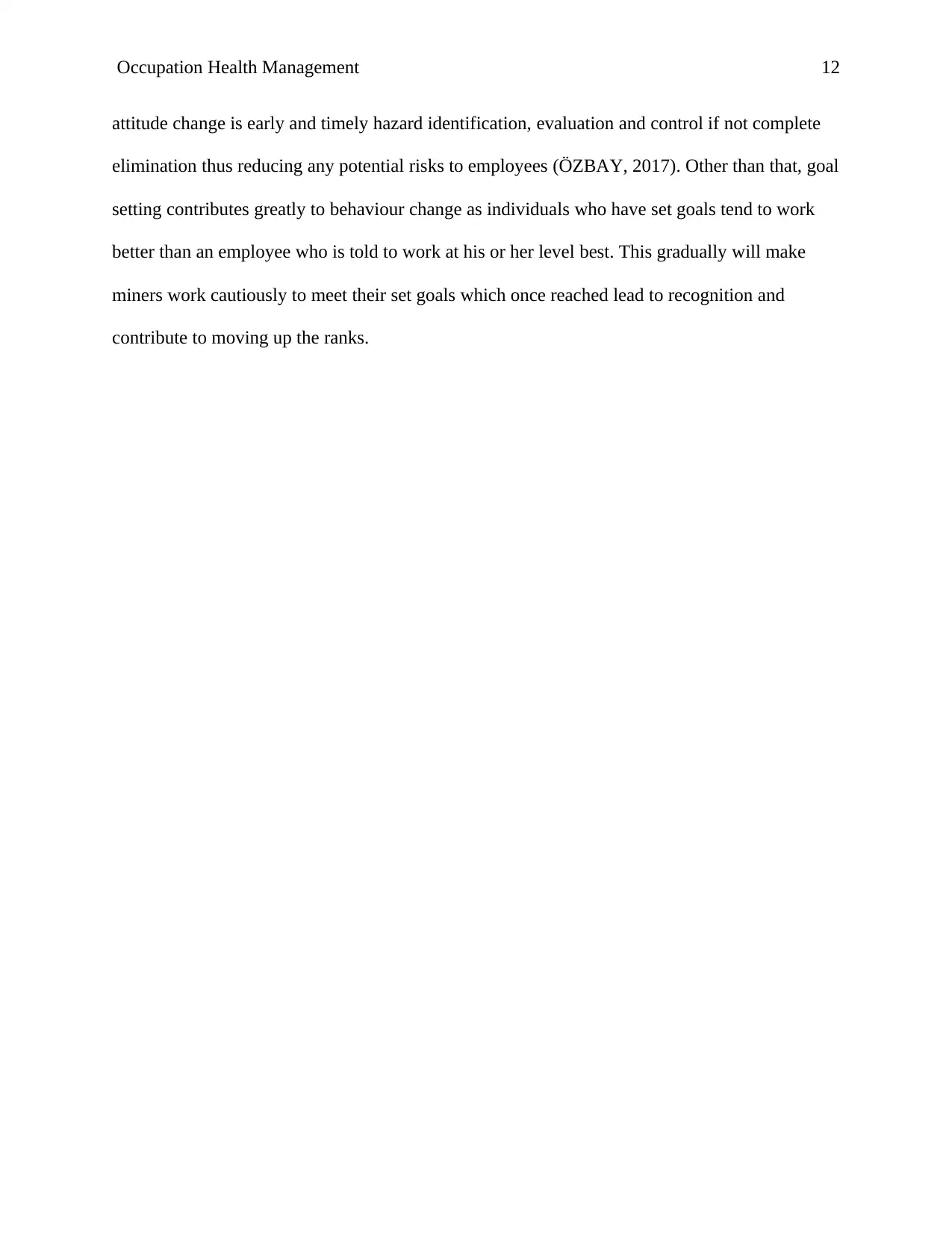
Occupation Health Management 12
attitude change is early and timely hazard identification, evaluation and control if not complete
elimination thus reducing any potential risks to employees (ÖZBAY, 2017). Other than that, goal
setting contributes greatly to behaviour change as individuals who have set goals tend to work
better than an employee who is told to work at his or her level best. This gradually will make
miners work cautiously to meet their set goals which once reached lead to recognition and
contribute to moving up the ranks.
attitude change is early and timely hazard identification, evaluation and control if not complete
elimination thus reducing any potential risks to employees (ÖZBAY, 2017). Other than that, goal
setting contributes greatly to behaviour change as individuals who have set goals tend to work
better than an employee who is told to work at his or her level best. This gradually will make
miners work cautiously to meet their set goals which once reached lead to recognition and
contribute to moving up the ranks.
⊘ This is a preview!⊘
Do you want full access?
Subscribe today to unlock all pages.

Trusted by 1+ million students worldwide
1 out of 30
Related Documents
Your All-in-One AI-Powered Toolkit for Academic Success.
+13062052269
info@desklib.com
Available 24*7 on WhatsApp / Email
![[object Object]](/_next/static/media/star-bottom.7253800d.svg)
Unlock your academic potential
Copyright © 2020–2025 A2Z Services. All Rights Reserved. Developed and managed by ZUCOL.





